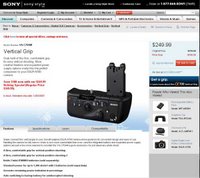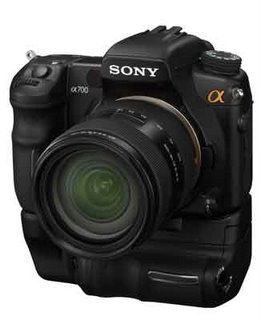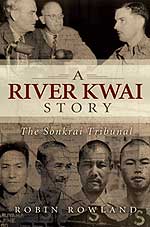At this moment the Canadian dollar has fallen back even with the United States dollar.
One US greenback may no longer be worth $1.10 Cdn, as it was when a friend of mine was up from New York a couple of weeks ago but it's at PAR. $1=$1.
So how's this for yet another big cross-border rip off.
I really like my new Sony A700 camera. Not so sure about Sony.
And the one additional feature that most A700 users want is the vertical grip, that is just that a vertical grip --but it also has space for two batteries.
The manufacturers list price has been $399.99 in Canada and $349.99 in the US.
 It isn't any more.
It isn't any more.Sony US is selling the vertical grip through Sonystyle.com at $249 and giving US customers free shipping up until December 31.
Here's the page from the US Sony style site,
but in Canada it is still $399.99 and no free shipping through the Great White North.
Here's the Canadian URL
And just for the record at the moment $1 Cdn = 111.04 Yen, $1 US =111.11 Yen. Not much of a difference is there???
Technorati tags
photography, Sony, Alpha 700, Canadian dollar
Labels: Ajpha 700, Canada, dollar, Minolta, photography, photojournalism, Sony, United States
CBC technology blog post How about a HDTV with that DSLR?
It begins with my first SLR.
When Minolta made the announcement that it was going out of business, I wrote a longer version of my experiences with Minolta in my blog post The End of the Minolta Era.
Here's a slightly updated summary:
My father gave me my first SLR, a Minolta SRT 101 for my 18th birthday many years ago.
That camera took me right across Canada in the summer of 1969 from Montreal to Victoria, across Canada to Halifax and then back to Montreal. I was part of the first Aventure Canadienne, one of Pierre Trudeau's first experiments in bilingual and bicultural exchange, twenty students, half Anglophone, half Francophone going across Canada in two blue minibuses.
I used the SRT 101 in journalism school and on my first job as a reporter/photographer on the Sudbury Star, and then I took it across Europe a year later. I took the SRT 101 with me for the year I worked in London,where it survived being tossed across a room by a crazy landlady.
In the early 1980s, bought the Minolta X700 just before I moved into broadcasting and used that camera for years...mostly landscapes since I wasn't shooting journalism at that time.
For video I used a Sony Hi8 camera to shoot my documentary for CBC's Pacific Rim report on my trip up the River Kwai and later bought a Sony DV camera).
I bought a Minolta Maxxum 4 around 2000 or so and added a Sigma zoom and a Minolta 50mm.
At the time when Canon and Nikon and other camera companies were going big on high end, professional digital, Minolta stood still--one reason they got into to business trouble.
I probably would have switched to Canon except for the fact that in October 2005, Minolta Canada went out of business before the company's other branches which closed down in January 2006.
That meant the retailers here in Canada wanted to dump their Minolta cameras and lenses (they didn't foresee the deal where Sony bought Konica-Minolta digital camera technology and patents)
So I got the 7D for $1000 instead of $2000, got a better mid range zoom and a wide angle and a flash --all at less than half the price it would normally have cost.
It appears that elsewhere around the world no one dumped Minolta lenses at fire sale prices after the Sony deal was announced-- the retailers knew the lenses were good for the upcoming Sony cameras.

So I have now all this equipment and most of it is compatible with the Sonys--and if, from time to time, I want to shoot film, most of the lens and equipment will work with the Maxxum film camera. So I am going to stick with cameras I know, know how to operate and like using.
I didn't have much time last Thursday for the hands on session with the Alpha 700. You will find a review from Doug Brown on the DPreview forum here.
Among the features that stood out for me in the Alpha 700 were:
The presenters were pushing a function key system that means you don't have to stop and look at the menu in midshoot.
Both in the PR book and the presentation Sony said the in camera image stabilization system is made to work with any lens--in other words all the Minolta lenses out there just waiting for a new digital camera.
Some of the "new" features were on the Minolta 7D which I use such as the auto focus/manual focus button.
One feature I found interesting is a white balance bracketing setting, three frames at different WB settings, could come in handy if you are shooting jpg in an unusual lighting situation.
Offers an optional vertical grip with a second battery with automatic switching to the second battery when the first gets low.
Shoots 5 fps -doesn't match the Mark III's 10 fps.(although Brown was told Sony was working on improving this).
Offers something called cRAW which compresses the RAW setting by 30 per cent.
Continuous shooting capacity is 18 frames RAW, 25 frames cRAW and 16 frames extra fine jpg, looks like the continuous mode is optimized for cRaw.
Doug Brown's review also said the Alpha 700 is the only DSLR on the market at the moment that shoots in the 16:9 aspect ratio. That will be a great advantage for me because broadcasters are now shooting mostly 16:9 as part of the transition to high definition and I am already shooting 16:9 assignments using my Lumix FZ50 point and shoot.
Sony Canada news release.
Technorati tags
photography, journalism, Minolta, Sony, Alpha 700,CBC, 16:9,
photojournalism
Labels: Ajpha 700, CBC, HDTV, Lumix, Minolta, Panasonic, photography, photojournalism, Sony




